Mock orange or mock-orange typically refers to Philadelphus, a mostly Holarctic genus of shrubs, particularly the species Philadelphus coronarius, which is widely cultivated as an ornamental plant.
Snowbell is a common name for several plants and characters and may refer to:

Styrax is a genus of about 130 species of large shrubs or small trees in the family Styracaceae, mostly native to warm temperate to tropical regions of the Northern Hemisphere, with the majority in eastern and southeastern Asia, but also crossing the equator in South America. The resin obtained from the tree is called benzoin or storax.

The Styracaceae are a small family of flowering plants in the order Ericales, containing 12 genera and about 160 species of trees and shrubs. The family occurs in warm temperate and subtropical regions of the Northern Hemisphere.

Juniperus squamata, the flaky juniper, or Himalayan juniper is a species of coniferous shrub in the cypress family Cupressaceae, native to the Himalayas and China.

Symplocos is a genus of flowering plants in the order Ericales. It contains about 300 species distributed in Asia and the Americas. Many species grow in humid tropical regions. This is sometimes considered to be the only genus in family Symplocaceae. Plants in this family are shrubs and trees with white or yellow flowers. The oldest fossils of the genus date to the lower Eocene of Europe and North America, with the genus being present in Europe as late as the Pliocene. Fossil seeds of †Symplocos granulosa are frequent in sediment rock layers of the Late Oligocene to the Late Miocene of Denmark, Germany, Austria and Poland. The fossil seeds are very similar to the seeds of the extan southern Chinese species Symplocos glandulifera and Symplocos sulcata. Fossil seeds of †Symplocos paucicostata are known from the Middle Pliocene sediment rock layers in Reuver, the Netherlands and from the Late Pliocene sediment rock layers in northern Italy. The fossil seeds are very similar to the seeds of the extant East Asian species Symplocos paniculata
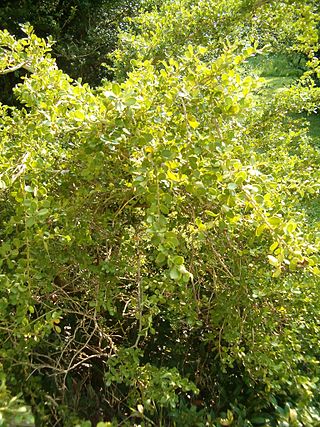
Buxus microphylla, the Japanese box or littleleaf box, is a species of flowering plant in the box family found in Japan and Taiwan. It is a dwarf evergreen shrub or small tree growing to 1 m (3.3 ft) tall and wide.

Styrax platanifolius is a species of flowering plant in the family Styracaceae known by the common name sycamoreleaf snowbell. It is native to northeastern Mexico in the states of Coahuila, Nuevo León, and Tamaulipas and the US state of Texas, especially on the Edwards Plateau.

Styrax americanus, the American snowbell or mock-orange, is a plant species native to the southeastern United States and the Ohio Valley. It has been reported from Texas and Florida to Virginia and Missouri. It generally grows in swamps and on floodplains and in other wet locations.

Styrax grandifolius, the bigleaf snowbell or bigleaf storax, is a plant species native to the southeastern United States, ranging from Virginia south to Florida and west to Texas and Missouri. The plant grows as a deciduous shrub or tree up to 6 metres (20 ft) high, and is most commonly found in upland forests of the southeast's piedmont. As the specific epithet suggests, the species has larger leaves than sympatric Styracaceae, with alternate, obovate leaves up to 14 cm long and 10 cm wide that are densely pubescent underneath. Flowers are borne during early summer in racemes containing up to 20 flowers.

Styrax redivivus, with common names that include snowdrop bush, California styrax, bitternut, drug snowbell, and chaparral snowbell, is a species of flowering plant in the family Styracaceae. It is a rare plant, native to California, a shrub which can grow to 4 metres (13 ft) in height.
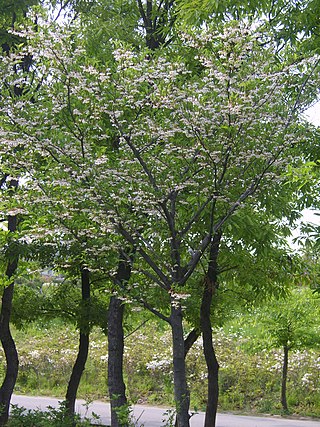
Styrax japonicus, also known as the Japanese snowbell, is a species of flowering plant in the family Styracaceae, native to Korea, Japan, and Southern China. Growing to 12 m (39 ft) tall by 8 m (26 ft) broad, it is a graceful, spreading deciduous tree with oval, upward-facing leaves which occasionally turn yellow or orange before falling in autumn. Masses of slightly fragrant, bell-shaped white flowers hang from the branches in summer, followed by fruits (drupes) which resemble olives in both shape and colour.

Carex breviculmis, called the Asian shortstem sedge, is a species of flowering plant in the genus Carex, native to Asia from the Indian subcontinent to Southeast Asia, China, Taiwan, Korea, Japan, north as far as Khabarovsk Krai, and Malesia, New Guinea, Australia, Norfolk Island and New Zealand. It has been introduced to the US state of Mississippi. Typically found in forests, it is quite shade tolerant.
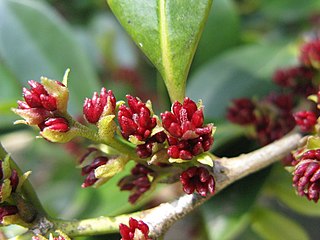
Distylium racemosum, the isu tree, is a species of flowering plant in the family Hamamelidaceae. It is native to subtropical eastern Asia; central and southern Japan, the Ryukyu Islands, South Korea, southeastern China, Taiwan, Hainan, and northern Vietnam. There are a number of cultivars, including 'Guppy' and the variegated 'Akebono'.
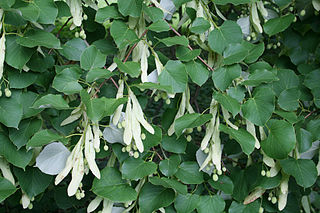
Tilia oliveri, the Chinese white lime or Oliver's lime, is a species of flowering plant in the family Malvaceae, native to central and southeastern China. It has found use as a street tree, and does well in the United Kingdom, but is not commercially available in the United States.

Buxus sinica, the Chinese box or small-leaved box, is a species of flowering plant in the family Buxaceae, native to central and southern China, Taiwan, South Korea, and Japan. A shrub or small tree, in the wild it is found in a variety of habitats, usually from 600 to 2,600 m above sea level. There are a number of cultivars, all derived from Buxus sinica var. insularis, including 'Winter Gem', 'Green Gem', 'Justin Brouwers', 'Wintergreen', 'Chegu', 'Tall Boy', 'Tide Hill', 'Winter Beauty', 'Green Mountain', 'Pincushion', 'Filigree', 'Green Velvet', and 'Sunny‑side'. In addition to its use in hedging, it is used in bonsai.

Spiraea salicifolia, the bridewort, willow-leaved meadowsweet, spice hardhack, or Aaron's beard, is a species of flowering plant in the family Rosaceae. A shrub, it is native to east-central Europe, Kazakhstan, all of Siberia, the Russian Far East, Mongolia, northern China, Korea, and Japan, and it has been widely introduced to the rest of Europe and to eastern North America. It has been cultivated since the 1500s for hedges and similar applications, but is not particularly well-behaved.
Prunus pogonostyla, the hairy-style cherry, is a species of flowering plant in the family Rosaceae, native to Manchuria, southeastern China, and Taiwan. A shrub or tree reaching 1.5 m (5 ft), with pink flowers, it is typically found growing on forested hillsides from 300 to 800 m.
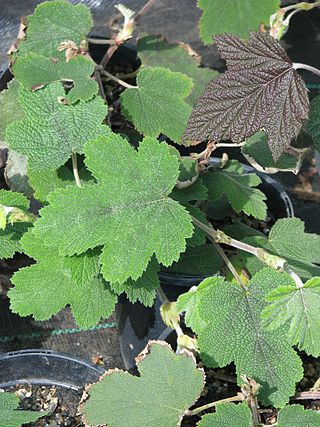
Rubus formosensis, the Formosan raspberry or Formosan bramble, is a species of flowering plant in the family Rosaceae, native to southeastern China, and Taiwan. It is found at a wide range of elevations, generally in habitats that have limited competition from other plants. A thornless shrub with a restrained climbing habit, reaching at most 2 m (7 ft), and with attractive evergreen leaves, it is available from commercial suppliers.
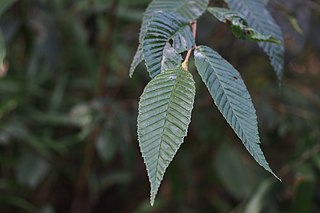
Alnus pendula is a species of flowering plant in the alder genus Alnus, native to Honshu and Hokkaido islands of Japan. An "exceptionally attractive" and "extremely elegant" large shrub or small tree, sources differ on whether it is introduced or native to Korea.


















